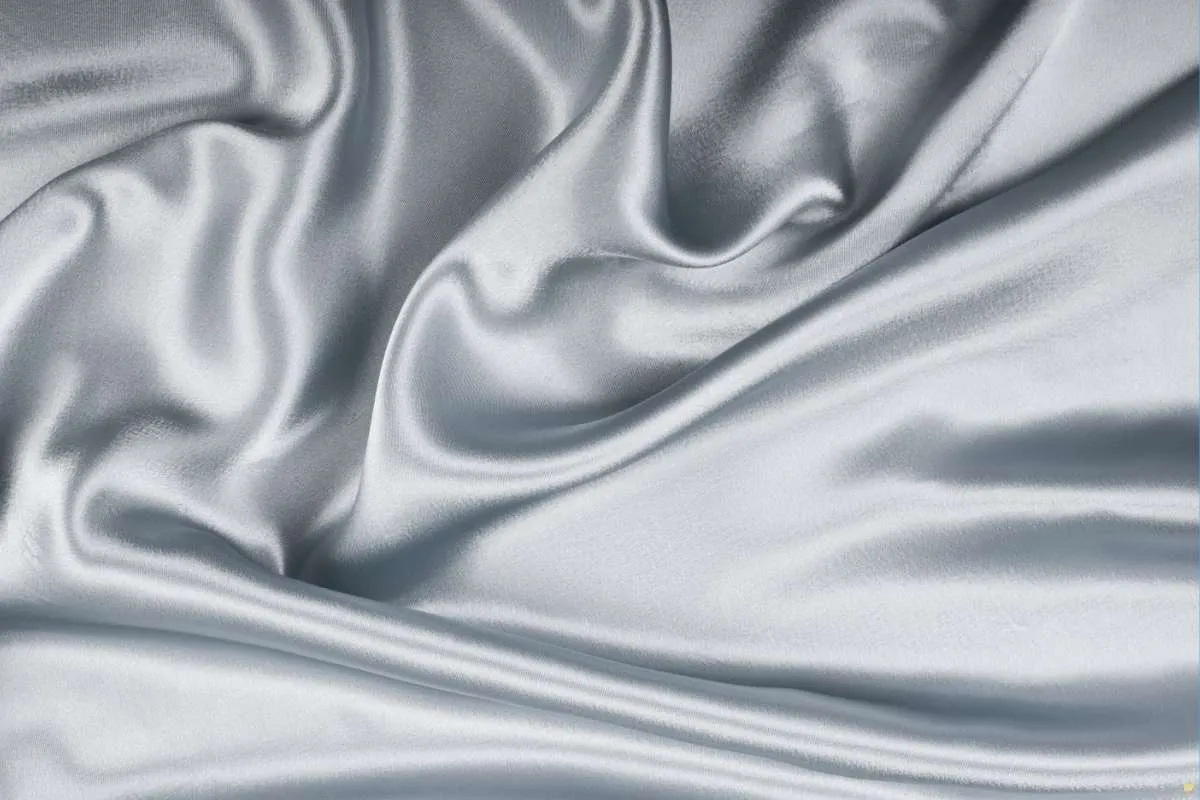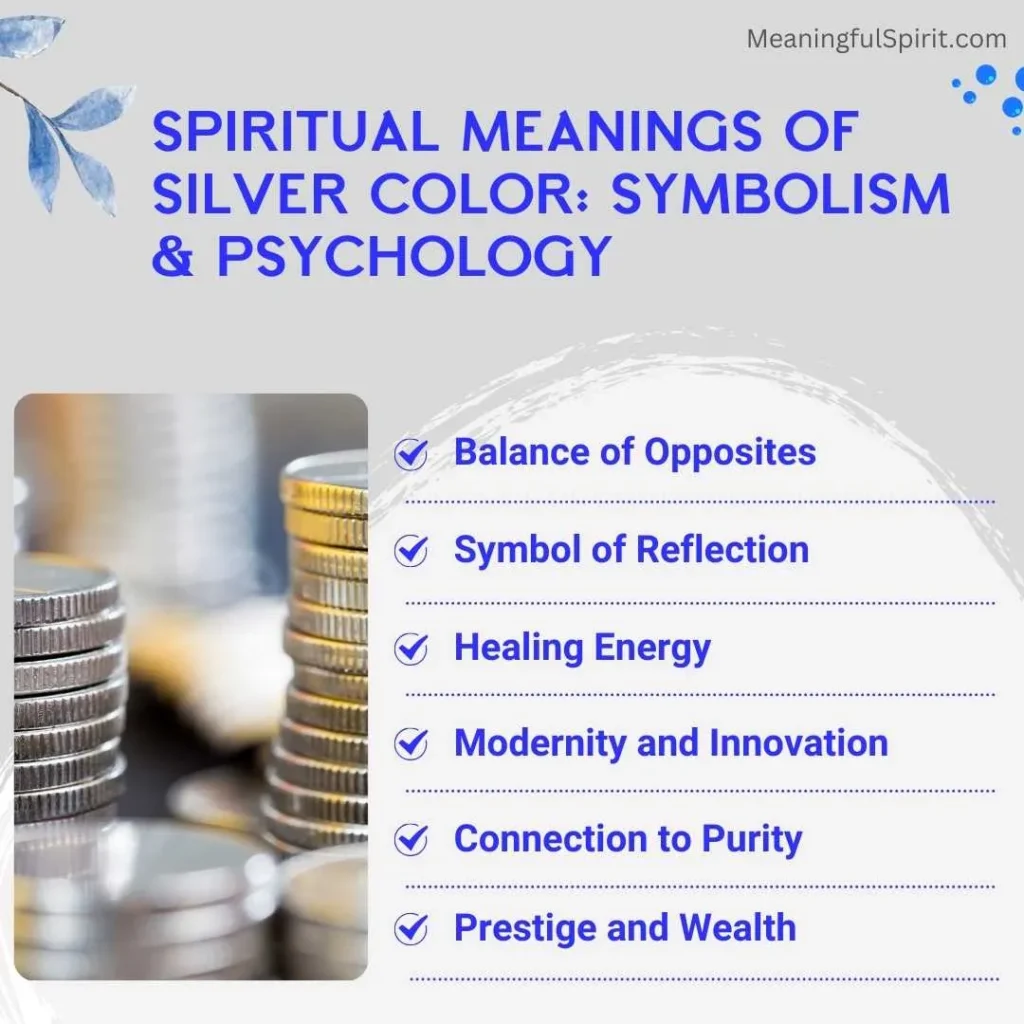10 Spiritual Meanings of Silver Color: Symbolism & Psychology

The color silver has fascinated humanity for centuries. It’s often associated with elegance, moonlight, and mystery. But silver is more than a beautiful hue—it carries spiritual, emotional, and psychological meanings that have inspired countless cultures, traditions, and art forms.
If you’ve been curious about the deeper symbolism of silver, this blog will guide you through its spiritual significance, psychological impact, and how different shades of silver are perceived worldwide.
Whether you’re a color symbolism enthusiast or someone exploring spirituality, there’s something intriguing for everyone here.
What Does the Color Silver Symbolize?
Silver stands out as a color of balance, sophistication, and innovation. It bridges the gap between the grounding qualities of gray and the brilliance of white. This balance makes silver a symbol of duality—blending modernity with timelessness.
It is also deeply tied to notions of intuition and feminine energy. Many cultures associate silver with the moon, which represents renewal, emotional calmness, and introspection. Its reflective quality is thought to symbolize clarity and self-reflection, inspiring us to look inward and find harmony.
Silver often signifies wealth and prestige due to its historical association with silver coins, jewelry, and art. While gold often screams opulence, silver exudes subtle elegance, reflecting a quieter, more graceful form of luxury.
Psychology of the Color Silver
From a psychological perspective, silver is known to have a soothing and calming effect. It’s not overbearing like gold nor neutral like gray—it sits comfortably in between, evoking feelings of trust and stability.
Silver also has mental-stimulating qualities. Its shimmering and reflective nature is often linked to modernity and innovation. This is why you’ll find silver used in branding for technology companies and luxury automobiles—it represents sleekness and cutting-edge progress.
Another interesting aspect of silver is its tied sense of detachment. While calming, it can occasionally feel aloof or distant. This sense of neutrality allows silver to act as a balancing force, inviting individuals to reflect without overwhelm.
10 Spiritual Meanings of Silver Color

Silver holds countless spiritual meanings across different schools of thought. Here are ten key interpretations:
1. Balance of Opposites
Silver is a fascinating color because it’s known for representing balance. It reflects the harmony between two opposite energies: masculine and feminine. These energies aren’t about gender but about qualities like strength and gentleness working together.
This balance can help people feel more centered and calm. When things feel overwhelming, silver is thought to encourage inner peace. It reminds you to pause, breathe, and steady your emotions instead of letting stress take over.
By symbolizing balance, silver can inspire a sense of fairness too. It encourages people to see both sides of a situation and try to make choices that are thoughtful and even-handed.
2. Connection to Intuition
Silver has a strong link to the moon, which is often connected to intuition and inner wisdom. People believe that silver can help sharpen your instincts, making it easier to trust your gut feelings.
It’s also thought to boost spiritual awareness. This doesn’t have to be complicated; it simply means being more in tune with yourself and the world around you. Silver is said to help during times of self-discovery, especially when you’re figuring out who you are or what path to take.
For many, silver represents a quiet, guiding energy. It’s believed to help people stay grounded while exploring deeper thoughts and emotions, offering a sense of direction when life feels uncertain.
3. Symbol of Reflection
Silver is often associated with self-reflection, like looking into a mirror. This is all about taking the time to think about your feelings, actions, and choices to understand yourself better.
This reflective quality can help bring clarity to your thoughts. When your mind feels cluttered, silver is believed to inspire a sense of calm focus, making it easier to sort through emotions and find solutions.
By encouraging self-reflection, silver helps people make more thoughtful decisions. It reminds you to think about not only what’s best for you but also how your choices might affect others around you.
4. Healing Energy
Silver is often associated with healing and restoration because many believe it helps balance emotions. It’s thought to absorb and neutralize negative energy, which can make people feel lighter and more at peace. This quality makes silver popular in spiritual practices that aim to clear emotional blocks.
Some people also think silver boosts emotional well-being by encouraging calmness. It’s said to promote a sense of stability, which can be helpful during times of stress or sadness. By supporting emotional balance, silver is seen as a tool for inner healing.
In addition to emotional benefits, silver is sometimes linked to physical health. Some believe it can protect against harmful energies, acting as a shield for the body and mind. This belief has made it a symbol of protection and renewal in many cultures.
5. Feminine Energy
Silver is often connected to feminine energy, as it represents qualities like gentleness and receptivity. These traits are tied to the calming and nurturing energy that silver is believed to bring. It’s also seen as a counterpart to gold, which is associated with more active, masculine energy.
The connection between silver and the moon strengthens this feminine symbolism. The moon is known for its soft, reflective light, and silver mirrors these qualities. This makes silver an ideal symbol for bringing softness and harmony to situations that may feel overwhelming or intense.
Many believe silver helps people connect with their inner emotions. By encouraging self-reflection, it’s said to help individuals understand their feelings and respond to challenges with grace. This makes silver a symbol of emotional strength wrapped in gentleness.
6. Modernity and Innovation
Silver is widely admired for its sleek and shiny appearance, which is why it’s often linked to progress and innovation. This metal is frequently used in modern technology, from electronics to advanced equipment, making it a symbol of creativity and forward thinking.
Because of its role in technology, silver is seen as a connection between tradition and the future. While it has been cherished for centuries, it continues to play a key role in developing cutting-edge tools. This blend of old and new gives silver a special sense of timelessness.
Silver is also thought to inspire people to think creatively and embrace new ideas. Many believe its energy encourages problem-solving and ingenuity, making it a symbol of growth and possibility in both personal and technological advancements.
7. Symbol of Transformation
Silver is often linked to change and transformation because of the way it reflects the cycles of the moon. Like the moon phases, silver reminds us that life is full of shifts and new beginnings, encouraging people to adapt and grow.
This connection to transformation also highlights the idea that challenges and changes are not something to fear. Instead, they can be opportunities to improve and rediscover yourself. Silver symbolizes the ability to move forward and evolve, no matter what life throws your way.
Its reflective nature also represents self-awareness. By looking inward and being adaptable, people can find ways to transform their lives and become stronger.
8. Connection to Purity
Silver has a natural connection to purity and cleanliness. While white is often seen as the strongest symbol of purity, silver shares these qualities in a simpler way. It represents honesty and straightforwardness, which are important values in life.
The shine and simplicity of silver can feel calming and refreshing, like a clear and honest moment that cuts through confusion. It reminds us to stay true to ourselves and approach situations with openness.
Additionally, silver’s link to purity is tied to its clarity. It doesn’t overwhelm but instead offers a quiet sense of peace and balance, helping people stay grounded in what truly matters.
9. Protection and Endurance
Since ancient times, silver has been thought to provide spiritual protection. Cultures from around the world have used silver to create amulets and charms to protect against negative energy and harm.
These beliefs stem from the idea that silver can act as a shield. It was seen as a metal with special properties that could keep bad things at bay. People trusted it to give them strength and safety when facing difficulties.
In addition to protection, silver is also a symbol of endurance. It shows how resilience and strength go hand in hand, reminding people to stay strong even in tough situations.
10. Prestige and Wealth
Silver has always been associated with prestige and wealth, even though it’s softer and quieter than gold. It’s a symbol of elegance and refined success, showing that wealth doesn’t have to be flashy to be meaningful.
Spiritually, silver encourages people to focus on achieving their material and personal goals with grace. It reminds us that success can be both external, like financial stability, and internal, like personal growth.
The value of silver also emphasizes balance. It suggests that both material and spiritual well-being are important and that true wealth comes from appreciating both aspects of life.
Color Silver Significance in Different Cultures, Arts, and Mythologies
Different cultures have their unique understanding of silver, blending its symbolism into their traditions, beliefs, and art.
- Western Cultures often link silver to the moon, emphasizing clarity, hope, and renewal. Historically, it’s been a symbol of wealth and craftsmanship, used in coins, goblets, and ornaments.
- Eastern Traditions, especially in China, view silver as a reflection of Yin energy, representing softness, intuition, and feminine attributes. It is also thought to repel what’s negative and restore harmony.
- Mythologies around the world link silver to goddesses, particularly moon deities. For instance, Greek mythology associates silver with Artemis—the goddess of the moon and hunt. Her silver bow and arrows symbolized purity and divine protection.
The arts and design world often uses silver as a representation of elegance, minimalism, and timeless beauty. From jewelry design to interiors, silver remains a timeless favorite.
Shades of Silver and Their Meanings
Not all silvers are the same. Slight variations in tone can convey completely different meanings:
- Bright Silver represents innovation and youthfulness. It shines brightly, symbolizing optimism and new beginnings.
- Matte Silver exudes stability and subtlety. It resonates with practicality and a grounded sense of achievement.
- Dark or Gunmetal Silver feels bold and powerful. It emphasizes resilience and strength, often used to portray dependability.
The Subtle Power of Silver
Silver’s quiet elegance carries profound spiritual and emotional meanings. Whether drawing inspiration from its balance, connection to intuition, or healing energy, silver is more than just a beautiful hue—it’s a symbol of transformation, clarity, and protection.
If you’re fascinated by exploring the symbolic world of colors, why not start paying special attention to the silver around you? It might be in the glint of jewelry, the metallic accents in decor, or even the subtle shimmer of moonlight. Each instance tells a story, waiting to be discovered.
You Might Also Like
1) 10 Spiritual Meanings of Gray Color: Symbolism & Psychology
2) The Spiritual Meaning of Colors and Their Symbolism
3) 15 Candle Color Meanings: Uses in Magic, Rituals & Spells
4) 10 Spiritual Meanings of the Black and Red Color Combination





